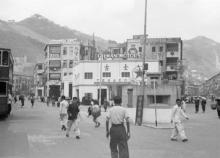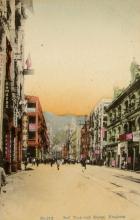Pillbox 057, Wanchai (Hennessy Rd / Johnston Rd / Stewart Rd) [1939-????]
Primary tabs
UWM's Harrison Forman collection has several photos of this area and the pillbox in 1941 (see below).
Interesting to see there was a gas station on the junction even then, and apparently under the same management. In 1941 the station sign says 'Texaco', and today's station is the ground floor of a building named Caltex House, Texaco being an ancestor of the Caltex brand.
Some points for discussion:
1. Direction.
Given that the defence of Hong Kong seemed so focused on preventing access to the area with Government House and the underground HQ, I was surprised to see loopholes facing West. It seems unlikely there would be an attack from that direction. Or did they just put a loophole facing in each direction? Unfortunately there aren't any photos from the East, so we can't see if there are any loopholes facing towards Causeway Bay.
2. Loophole design.
If you look at the loopholes on this pillbox, you'll see that the openings have a stepped appearance. As far as I remember, all the other pillboxes we've seen in Hong Kong (ie those that remain today) have a smooth wall sloping in to the opening. The problem with the sloping wall was that it acted like a funnel, helping direct ricochets into the pillbox. Not ideal! The stepped loopholes were meant to overcome this problem.
I think I remember reading that early pillboxes built in the UK had sloping loopholes, but later models were built with the stepped loopholes. So one interpretation could be that these street pillboxes were built later than the coastal pillboxes that still remain? Or was the layer of stones and concrete (meant as camouflage) applied too enthusiastically to the loopholes on coastal pillboxes, filling in the steps?
3. Was the pillbox used?
The last days of the British resistance saw fierce street fighting in Wanchai. At the time of surrender the British line had been pushed West past this pillbox, so I wonder what its involvement in the fighting was?
Here are the Harrison Forman photos that show the pillbox. (You can click any photo for more details)
Photo #113. Hennessy Rd looking SE. Trams turning on Johnston Rd in background:
Photo #114. Johnston Rd looking N. Pillbox & junction with Hennessy Rd at right edge of photo.
Photo #115. Johnson Rd looking N. Junction of Hennesy & Stewart Rd in background.
Photo #117. Hennessy Rd, Johnston Rd in background.
Photo #159:




Comments
The same view in the 1950s
We've been sent this photo. No sign of the pillbox - I wonder when it was removed?
Another view, this time in the 1930s
This photo received by email:
I do have ideas about the
I do have ideas about the time the pillbox was demolished. The first reason was because of the establishment of the People's Republic of China. In 1949, there was a rumor (and almost became real) that the PLA would cross the boarder and took Hong Kong. So between 1949 to early 1950s there was a wide-range demolition of former defence structure in Hong Kong, including almost all pillboxes in Shing Mun Redoubt and Gin Drinkers' Line (but strangely it was not all, it could be because of the lost of documents and they simply didn't whereabouts the rest). So this pillbox, which is commanding the main route in Hong Kong Island, could be the victim of this demolition. Also, in 1950s there were more people leaving China for Hong Kong and so the city grews quickly, and thus the traffics. So the pillbox could be demolished in 1950s also because of its location in the middle of the road!
re: PB57
Thanks Rusty. Hopefully we'll find some more photos of the area from the 1940s and 50s, and be able to pinpoint the date better.
More details about this pillbox
I have checked the Japanese documents and books showing that there was no fighting around this pillbox and thus it looks good in these photos. Generally all pillboxes involved in the battle were either demolished by heavy artillery fires or full of damages done by machine gun fires and grenades.
It is a bit "lucky" that the pillbox was built rather inland and so it was not attacked by the Japanese siege artilleries and even if the Japanese did on 24th or 25th December, when the battle was about to end, the Japanese siege artilleries simply could do nothing for its ammuition was running low after days of siege! So the pillbox survived well into post-period.
I have been the site last week and everything has changed only except the "Tex" of the nowadays Caltex Gas Station...
About the pillbox design... I suggest that the pillbox could be a late version of the pillbox... As far as I know the Colonial Government met difficulties to build pillboxes in northern shore of HK Island for the civilians simply did not want a military stuff built next to them. Since the government met no difficulties in building pillboxes in southern shore and occasionally on the hills, so those pillboxes built first and the loopholes were in smooth shape. However, the design changed before the pillboxes in northern shore built and thus it appeared in stepped shape. I have no proof about this guess, but I do experienced that pillbox design were different in some occasions and that could only means the time were different. For example, you can noticed that there were two airshafts plus one periscope shaft on the top of this pillbox. But most of the pillboxes I have seen in HK Island, either on hills or in southern shore, appeared to be one periscope shaft plus one airshafts closely BEHIND the periscope shaft, a big different as you can see in the photos.
Also, those pillboxes in Gin Drinkers' Lines were different even among themselves! That could only means they were built in different times depending on different designs...
re: More details about this pillbox
Hi Rusty,
Good to hear from you again. If I didn't make it clear above, the reason the pillboxes are in such good condition in these photos is that the photos were taken in 1940-41, ie before any fighting. (More details on estimated dates here.)
We haven't seen any photos of the area immediately after the war, so I'm not sure if they how much damage they received, or whether they were demolished during or after the Japanese occupation. Hopefully we'll find a photo for evidence at some point.
Thanks for your extra information about the pillboxes,
regards, David
Notes
Year completed is: Approximate
Condition at last visit: Demolished
Date of last visit: Jul-1998
Ref: ROB-00661
Other: